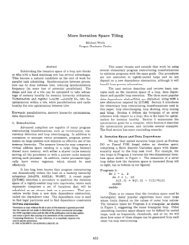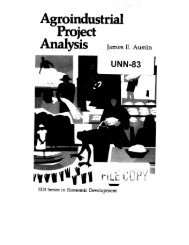Chapter 17 Radio Propagation Models
Chapter 17 Radio Propagation Models
Chapter 17 Radio Propagation Models
Create successful ePaper yourself
Turn your PDF publications into a flip-book with our unique Google optimized e-Paper software.
¡<br />
Table <strong>17</strong>.1: Some typical values of path loss exponent ¡<br />
Table <strong>17</strong>.2: Some typical values of shadowing deviation §©¨<br />
¡ ¢ ¤ ¦ <br />
¤ ¦ ¡£¢<br />
¡ ¢ ¤ ¦ %<br />
¦'& ¡£¢¥¤<br />
<br />
<br />
Environment<br />
Outdoor Free space 2<br />
Shadowed urban area 2.7 to 5<br />
In building Line-of-sight 1.6 to 1.8<br />
Obstructed 4 to 6<br />
Environment<br />
Outdoor 4 to 12<br />
¢¤£¦¥ (dB)<br />
Office, hard partition 7<br />
Office, soft partition 9.6<br />
Factory, line-of-sight 3 to 6<br />
Factory, obstructed 6.8<br />
The shadowing model consists of two parts. The first one is known as path loss model, which also predicts the mean received<br />
power at distance , denoted by . It uses a close-in distance as a reference. is computed relative to as<br />
¢ ¤ §¦ ¡ ¢ ¤ ¦<br />
follows.<br />
¡ §¦ ¤ ¢ ¡<br />
¡£¢¥¤ ¦<br />
(<strong>17</strong>.4)<br />
¨<br />
¡ ¢ ¤ §¦<br />
is called the path loss exponent, and is usually empirically determined by field measurement. From Eqn.<br />
¨<br />
¡ (<strong>17</strong>.1) we know that<br />
for free space propagation. Table <strong>17</strong>.1 ¡ gives some typical values of . Larger values correspond to more obstructions<br />
and hence faster decrease in average received power as distance becomes larger. can be computed from Eqn. (<strong>17</strong>.1).<br />
¦ ¤ ¢ ¡<br />
The path loss is usually measured in dB. So from Eqn. (<strong>17</strong>.4) we have<br />
$ (<strong>17</strong>.5)<br />
¨ <br />
¡! #"<br />
¨<br />
The second part of the shadowing model reflects the variation of the received power at certain distance. It is a log-normal<br />
random variable, that is, it is of Gaussian distribution if measured in dB. The overall shadowing model is represented by<br />
*),+ ¨ (<strong>17</strong>.6)<br />
¨( <br />
¡! #"<br />
¨<br />
where + ¨ is a Gaussian random variable with zero mean and standard deviation § ¨ . § ¨ is called the shadowing deviation,<br />
and is also obtained by measurement. Table <strong>17</strong>.2 shows some typical values of § ¨ . Eqn. (<strong>17</strong>.6) is also known as a log-normal<br />
shadowing model.<br />
The shadowing model extends the ideal circle model to a richer statistic model: nodes can only probabilistically communicate<br />
when near the edge of the communication range.<br />
166














![Problem 1: Loop Unrolling [18 points] In this problem, we will use the ...](https://img.yumpu.com/36629594/1/184x260/problem-1-loop-unrolling-18-points-in-this-problem-we-will-use-the-.jpg?quality=85)

